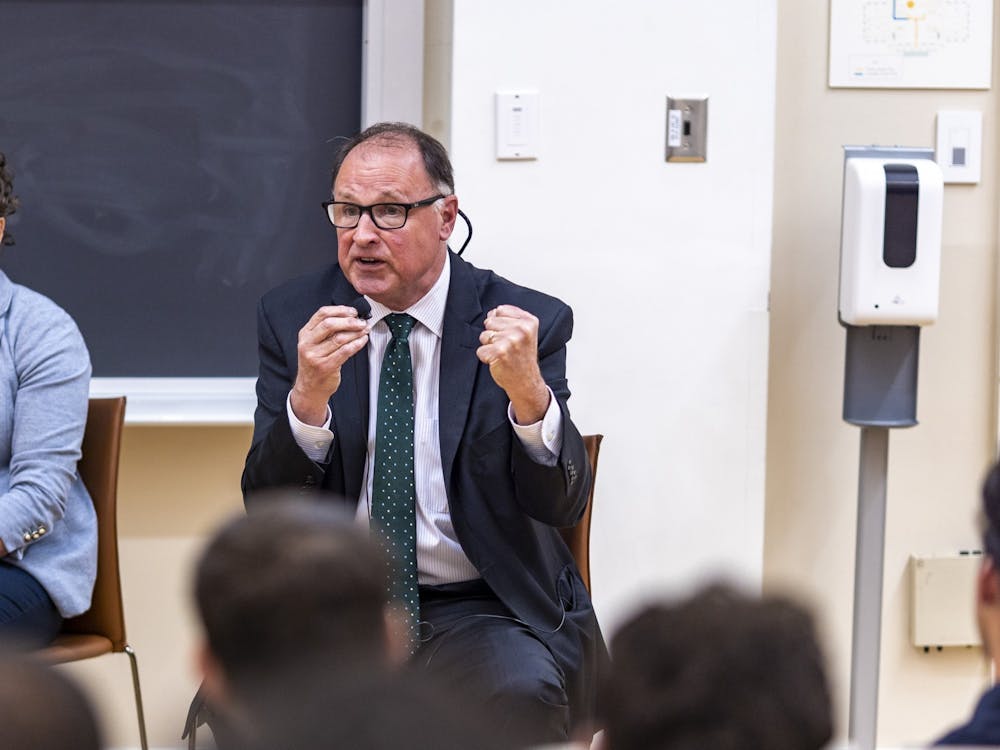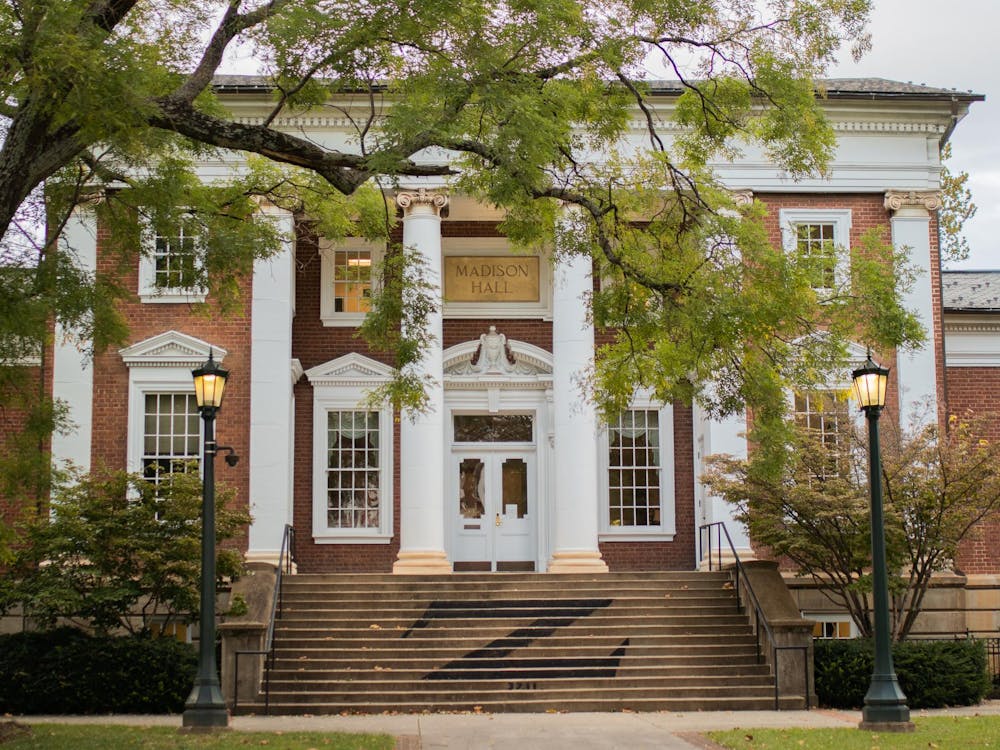Data on Pav Resturants:
Cranberry Farms | Chick Fil-A | Healthy Choice Deli Meats | Freshens Yogurt
What to eat? Or more importantly - where to eat and what to pay?
A plethora of gastronomic goodies awaits at Pavilion XI, offering students, faculty and staff several lunchtime choices. But choosing a healthy meal can be difficult as waffle fries and meat-lovers pizza lure the taste buds.
Paula Caravati, the University's Dining Services Nutritionist, said the key to a healthy Pav dining experience is moderation and careful consideration of all that is offered by each food item.
She said this includes a good balance of carbohydrates and fiber while not placing too much emphasis on protein.
"Fifty to 60 percent of your intake should be carbohydrates," Caravati said, dismissing the mindset of the 1960s and '70s that, the fewer carbohydrates in one's diet, the better.
As for meat and other sources of protein, "not more than five to seven ounces of protein per day. That's all you need - max," she said.
Caravati suggested a Caesar salad with low-fat dressing, avoiding too much grated Parmesan cheese. She said a bagel or other grain product would be a good accompaniment for the salad.
"I hate to say any food is a forbidden food," she added. "That's where people get into trouble because people end up craving something, and sometimes people may binge [as a result]. That's why moderation is important."
Caravati said students should avoid eating frozen yogurt as a meal substitute and instead eat it along with a meal or as a dessert. She also said students should not be afraid of fat and that 20 to 25 percent of caloric intake should be from fat.
Student Health Clinical Nutritionist Susan Del Gobbo said people should listen to their bodies in choosing what to eat.
"Food is sensual, it should be enjoyment, it should be pleasurable," Del Gobbo said. "Eating delicious foods and nutritious foods are not mutually exclusive."
Pav pricing
But in addition to health considerations while dining at the Pav, one should be wary of one's wallet. While officials say University food prices are in tune with the market prices for similar food products, some discrepancies remain.
Loose candy, for example, is sold in the Pav for 39 cents per ounce, or $6.24 per pound. At the Kroger supermarket on Emmet Street and Hydraulic Road, according to co-manager Will Fenne, loose candy prices range from "a dollar and change" per pound to $3.99. Gummy bears, Fenne said, cost $3.99 per pound.
The pricier, more upscale Harris Teeter supermarket sells all loose candy for $5 per pound - still cheaper than what the Pav offers.
At Freshëns Yogurt, Pav prices also exceed those set by the national company. Five-ounce, seven-ounce and eleven-ounce cups of frozen yogurt at the Pav cost 20 to 30 cents more than the maximum suggested retail price set by the Freshëns Yogurt company.
The company suggests charging $1.19 to $1.39 for a small five-ounce cup; $1.49 to $1.69 for a medium seven-ounce cup, and $1.99 to $2.19 for a large 11-ounce cup.
At the Pav, however, prices for the small, medium and large yogurts run at $1.59, $1.89 and $2.49, respectively. The Smoothie prices follow a similar pattern.
The national company suggests $2.99 to $3.25 for a regular Smoothie and $3.50 for a Smoothie with a nutritional supplement such as protein powder. At the Pav, Smoothies cost $3.39, and a nutritional supplement costs 49 cents extra.
Freshëns is located on over 300 college campuses and, by law, the company recommend prices but cannot dictate them, Freshëns Development Manager Jennifer Sander said.
"Because we are a nationally branded company, we pretty much garner street prices," Sander said. "It is up to ARAmark to design prices. A lot of our stores in California's prices are higher. In blue collar areas, prices are lower."
Chick-fil-A prices at the Pav, on the other hand, are exactly those recommended by the national, Atlanta-based company headquarters.
"If it's a national brand like Chick-fil-A or Freshëns, we probably go with either their national pricing or their local pricing," University Dining Services Director Ed Gutauskas said.
While Chick-fil-A and Freshëns are national brands, most Pav eateries, like Cranberry Farms, are from ARAmark, a catering company that provides most food services to the University.
"In terms of the ARAmark brand, we do an extensive survey of restaurant prices ... we do an extensive comparison of what the market prices are and then make recommendations to the University if any of the prices need to change," Gutauskas said.
Bringing on the change
Gutauskas said student input through scheduled customer satisfaction surveys have helped the Pav expand its services.
"We talk to students about what isn't there, what they like and what they don't like," he said.
He added that such student input led to the installation of the Newcomb Hall Bakery, which was fueled by students putting "more bagels" as their number one choice for another eatery at the Pav.
"We look at what's available to us. We would want to look at perhaps a burger concept," Gutauskas said.
As to why Chick-fil-A was chosen as opposed to a restaurant like McDonald's, Gutauskas cited size restrictions and also company's interest in being on a college campus as another important factor in determining what restaurants come to the University.
Part of the issue in bringing in nationally franchised fast food restaurants lies in the dilemma of how much control a college or university can exert over these operations.
Virginia Tech and Radford University are the only two universities in Virginia that are self-operated - that is, they do not employ a catering service such as ARAmark or one of its competitors. Virginia Tech offers students such fast food brands as Chick-fil-A, Freshëns and Pizza Hut - franchises also offered at the University.
But Johnson said expansion of dining options is not always as easy as determining students' desires or needs.
Some restaurants do not license, that is, they do not allow a branch of their restaurants to come to a college campus and have its profits go to the college itself. They instead allow only a franchise branch, or a division of their restaurant that is operated by their own people. A franchise rents space from the college and makes its own profits.
"McDonald's [for example], won't license. They'll franchise," Johnson said. "Whatever money they make is their profit. The problem with that is that if there's any money to be made, we want to make it and make it for the students. We want to run it and want to control it."
He said restaurants like Burger King and Wendy's do not license either.
"Sometimes it's student preference or customer preference, and you could vote for McDonald's all day long, but if they won't come, they won't come," he added.
Johnson said Tech has tried to attract restaurant chains such as Chili's, Bennigan's and TGIFriday's, but their setup has prevented them from entering the college campus scene.
"It's just difficult because their mind is somewhere else," he said.






